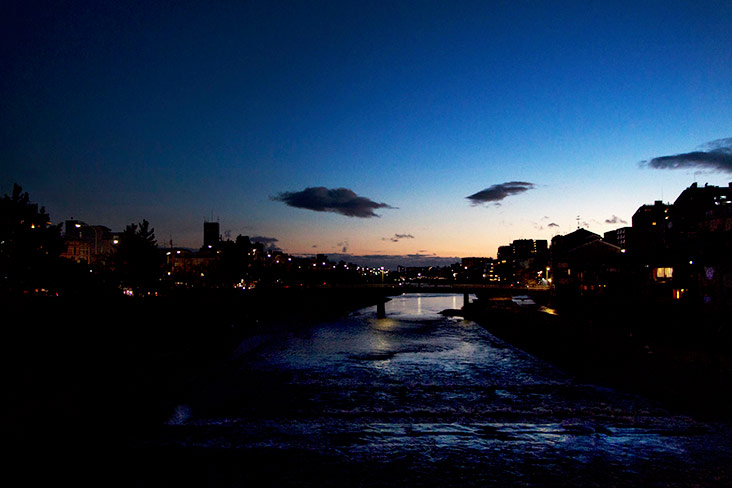KYOTO, June 24 — Some cities are made for walking. Indeed, aimless walking makes for the best adventures, especially when you’re a stranger in a foreign land.
This is how we discovered our own izakaya (tavern) in Kyoto, a place to return to again and again. It’s not unlike the one in Midnight Diner, a Japanese TV series where different characters turn up as patrons every episode, sharing stories and simple dishes such as omu-raisu (omelette rice) and sautéed yam (nagaimo no sote).
Not a bad way to spend an evening.


We begin at Gion, the old geisha district east of the Kamogawa (Kamo River). There’s a momentary culture shock, leaving the modern roads and traffic lights and entering the realm of machiya — traditional wooden merchant houses with their signature latticed fronts and sudare blinds made from bamboo.
The sun sets, deepening the shadows surrounding the machiya and transforming their distinctive ichimonji roofs into silhouettes. Street lamps light up. From the Gion Shijo station, we cross the Shijo Bridge. The Kamo River flows placidly below us as we walk the span of Shijo-dori, Kyoto’s busy Fourth Avenue.
Before we reach the Kawaramachi station, we decide on a whim to turn left, an unplanned detour down a back alley. It makes for a picturesque stroll, with the tree-lined Takase River (Takasegawa) running beside us.
Though it’s called a river, the Takasegawa is actually a canal. That hardly lessens its beauty however; in Kyoto, the canals are framed by sakura (cherry blossoms) in spring and lit by the rows of izakaya in the evening.

All the walking is making us hungry so we investigate our dining options. It’s really easy — perhaps too convenient — to search for the nearest reasonably priced and positively reviewed restaurant on our smartphones these days. But there’s more fun to let our intuition guide us when our bellies are growling (there’s a reason it’s called a gut feeling, after all).
We observe toro (Japanese lanterns) all lined up, hand-painted with elegant calligraphy. These are typically found at Buddhist temples but also in front of shops. There’s no finer invitation than a well-lit toro with striking calligraphy, if one is an eatery. One diner stands out from the rest with a resplendent akachochin (red lantern). And so we enter.


We are welcomed with a solitary greeting of “Irasshaimase!” It’s not uncommon for an izakaya to be manned by a solitary cook. Far rarer are shops that are non-smoking establishments, which is the case with Tempura Washoku Kamogawa (its name translates unfussily as “tempura and Japanese food along Kamo River”).
There are only two other patrons inside, seated on the right side of the counter. They smile at us while we set up the foldable chairs ourselves. The entire length of the counter would sit maybe six people, so izakaya dining is always an intimate experience. We’re not quite knocking elbows with our neighbours but there’s no room for dramatic punctuations of conversation for those who talk with their hands.

The cook, Yamaguchi-san, starts us off with a hot dish, to warm us from the chill outside. He whips up a mixture of eggs, shoyu (soy sauce) and dashi broth. Rolling the egg batter in a rectangular pan, he makes tamagoyaki (sweet egg omelette) for us. It tastes amazing freshly made, the steam escaping as we take our first bite.
The shop’s specialty is tempura, of course, given its name. And what is presented before us doesn’t disappoint: lacy, light as air batter barely coating pieces of kabocha (pumpkin), gobo (burdock), renkon (lotus root) and shiso leaf. Every bite simply dissolves in our mouths.


Next, we are served korokke (Japanese croquettes) fresh from the fryer. Coated with fine panko breadcrumbs and filled with a mixture of mashed potatoes and white sauce, these make for perfect post-clubbing bites. The drizzle of sweet and tangy tonkatsu sauce adds a nice hit of acidity.
In between dishes, our fellow diners ask us where we are from through an enthusiastic use of hand gestures (as much as the cramped quarters would allow). Somehow, despite us not speaking much Japanese and they not any English at all, they manage to mime the Petronas Twin Towers to demonstrate they’ve visited KL before.
Yamaguchi-san presents us with a platter of nigirizushi that he had deftly shaped by hand. The variety of sushi — maguro (tuna), sake toro (salmon belly), ebi (tiger shrimp), ika (squid), hotate (scallop), aji (Spanish mackerel) and cold tamagoyaki — is familiar but tastes better somehow. It’s the ambience and the company, we reckon.

In lieu of a rice dish such as ochazuke (where green tea and dashi is poured over rice), we finish with simple comfort fare. A little natto (fermented soybeans), some stewed vegetables and fresh tofu — and we feel like we’ve cancelled out any fried foods we had earlier!
It’s not quite midnight when we depart the diner, saying “Gochisosama deshita!” to the owner in appreciation of a wonderful meal. There are neon rainbows reflected on the gently rippling surface of the Takasegawa, reminding us the night is still young for many. Surely here, just like us, they’ll find a midnight diner of their own.
Tempura Washoku Kamogawa
140-6, Hashimotocho, Shimogyo-ku, Kyoto, Japan
Open daily 12pm till late
Tel: +81-75-344-0468






















